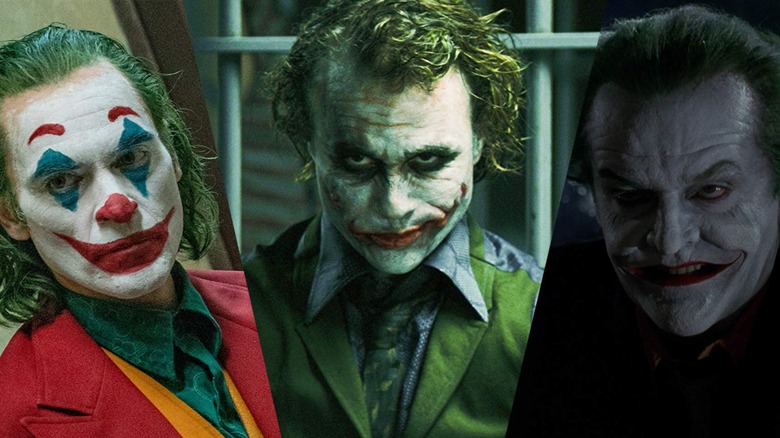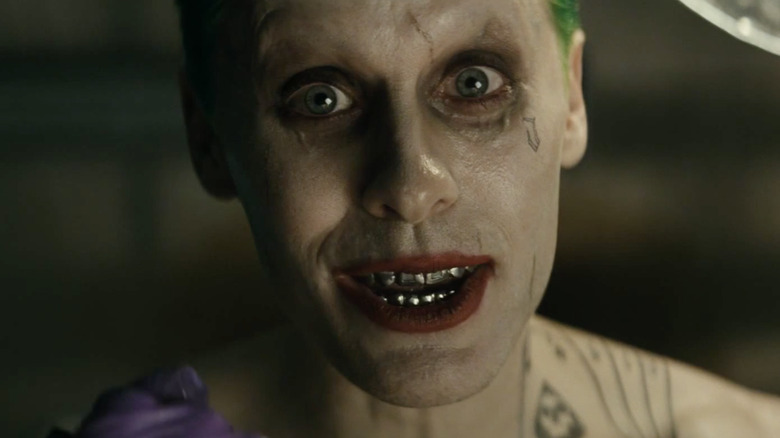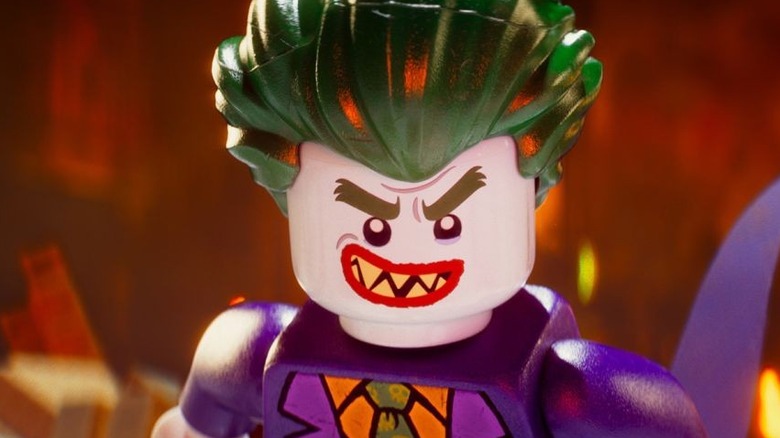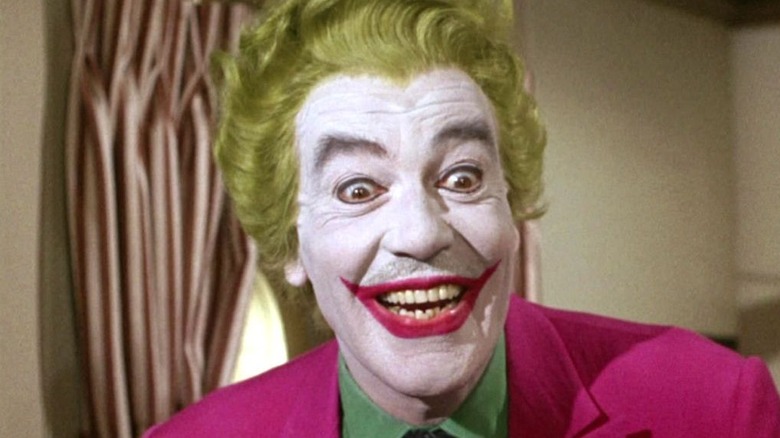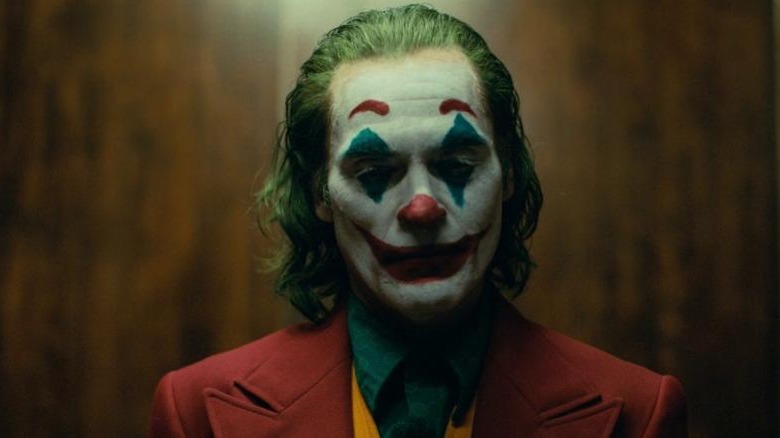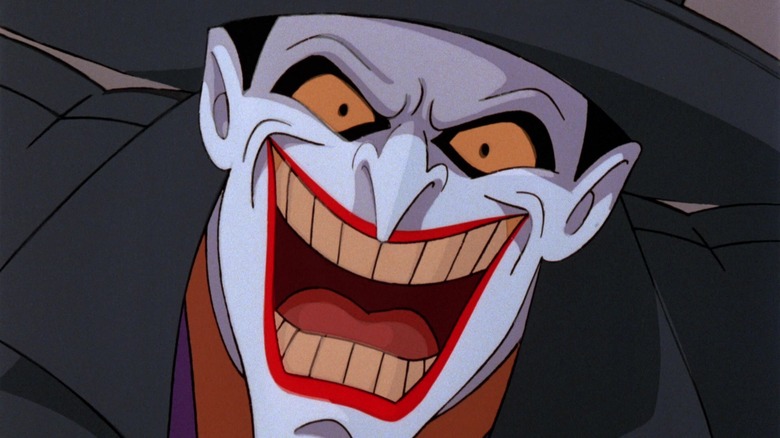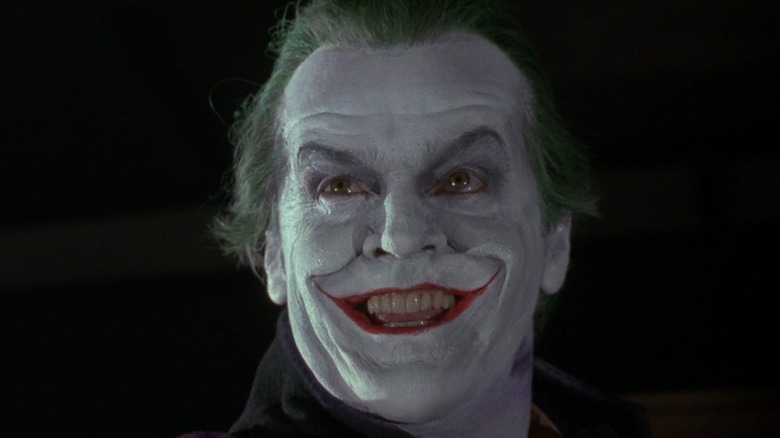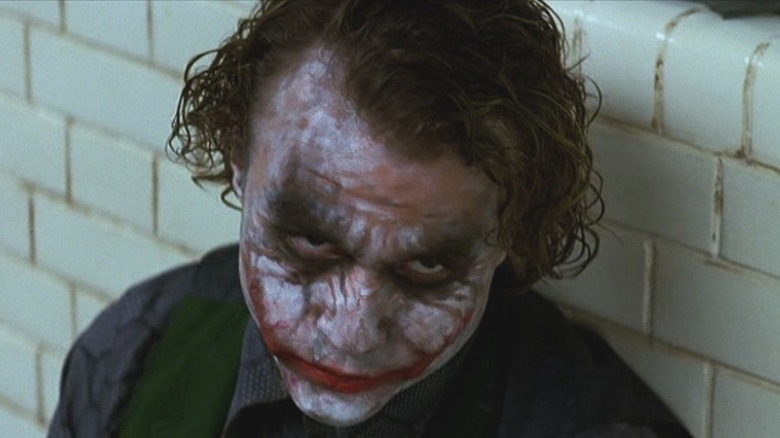Joker's Wild: Ranking The Cinematic Versions Of The Clown Prince Of Crime
While many a superhero film has had a villain problem, the Joker is one villain from the comics medium who has not only translated well, but also lent himself to a succession of compelling reinterpretations. He's the greatest comic book villain of all time and he's lit up the big screen with equal gusto. With Joaquin Phoenix's Joker coming off a record-breaking box-office weekend, this is as good a time as any to rank the various iterations of the Clown Prince of Crime on film.
For an old-school fan of the J-man, it's tempting to include Batman: The Animated Series and the 1960s live-action Batman TV series on this list. Both feature classic depictions of the Joker. Thankfully, their Jokers had such a taste for the theatrical that they also crossed over into movies. Not counting the animated movie Batman: The Killing Joke, which played in theaters for one night only before going direct-to-video, there have been seven cinematic Jokers since 1966.
If it doesn't feel like we're playing with a full deck here, well, since when has the Joker ever been wired that way? Regrettably, we don't have time to mess around with the Proto-Jokers of the TV series Gotham, or any of the animated, direct-to-video Jokers of the DC Universe Movies. This is the meat-and-potatoes ranking of Jokers. I've developed a secret algorithm for a precise ordering that is infallibly correct. It's called the Smylex Algorithm. "And here we ... go."
7. Jared Leto in Suicide Squad
The Joker in Suicide Squad feels more like a wisp from a montage than an actual movie character. He leaves us with a fascinating case study in how a film's editing can eschew lucidity in favor of cacophony, to the detriment of its characters.
Philosophically, I'm not opposed to a Joker who has had his front teeth knocked out by Batman, so that he now sports a shiny grill along with his prison tattoos. I'm not even all that bothered by the goofy tat on his forehead that reads, "Damaged." I mean, whatever. We're all damaged, right?
The real issue with this Joker is that if you watched all the trailers and TV spots for Suicide Squad back in 2016, then you would have already seen the bulk of Leto's performance (and maybe everything else worth seeing in the movie. That's up for debate.)
When the Joker pops up in Suicide Squad, it's frequently in flashback form. Fever-dream glimpses of him come to us through the mind of Harley Quinn. For an electroshocked brain such as hers, you could certainly make the case that memories should play like vignettes from an audiovisual nightmare. Unfortunately, this comes at the expense of Joker, who only gets to breathe as a character in scenes like the one where he confronts Harley's prison guard.
On the set of Suicide Squad, Leto's method acting, or douchebaggery, or whatever you want to call it, reportedly included gifting his coworkers with live rats as well as sending them used condoms, dildos, and anal beads, among other things. Even though these stories came straight from the lips of Leto's co-stars – seemingly reputable sources, like Will Smith and Joel Kinnaman — Leto later denied some of the rumors, as did director David Ayer (up to a certain point).
Taking a cue from Leto's Joker look, perhaps, Suicide Squad's cast famously gave each other matching tattoos. In today's day and age, I wouldn't put it past a tight-knit cast like that to fabricate wild stories, as a gag, in the hopes that the news would go viral and garner more publicity for their movie. Who'd have thunk it, but when Angie Han interviewed Margot Robbie for /Film in 2016, Robbie said that Leto was "respectful, professional, and lovely."
What we have here with this Joker is an instance where the look of the character and the dubious on-set stories about the actor portraying him are more interesting than what's onscreen. Whatever the truth is about Leto, there's a separate strand of hate that people seem to have for him, over and above the behind-the-scenes legends that surround Suicide Squad. It's affected public perception of his Joker and I can't really comment on it beyond what I've learned from night-Googling, "Why do people hate Jared Leto?"
In the final analysis, the version of Leto's Joker that survives in the theatrical — and even the extended — cut of Suicide Squad is simply too insubstantial to warrant a higher spot on this list. We should take no pleasure in seeing any film fail to knock it out of the park with Joker. Somewhere in the world right now, some disappointed DC fan is thinking of Leto's Joker as they rewatch Jack Nicholson's and hear him recite the line, "If you could see inside, I'm really crying. You might join me for a weep."
6. Zach Galifianakis in The Lego Batman Movie
Zach Galifianakis is a funny guy. Inborn comic talent isn't a prerequisite, but a plus in the Joker-actor column. Two weeks before the new Joker movie landed in cinemas, Netflix's Between Two Ferns: The Movie dropped (read our review here). It showed that Galifianakis still passes the laugh test when insulting celebrities and being maced in the face by cuckolds. In the 2000s, Galifianakis had a following for his comedy, but it was really ten years ago, in the summer of 2009 — when he co-starred in the smash-hit The Hangover — that he became a big bearded blip on everyone's movie radar.
That film's director, Todd Phillips, has since gone on to helm said Joker movie, while Galifianakis, in 2017, lent his voice to the lisping, pointy-toothed Joker in The Lego Batman Movie. What makes Lego Joker so endearing is his codependency on Batman. He just wants to be seen, recognized as an essential part of Batman's life. Naturally, he regards himself as Batman's greatest enemy. We're all on the same page about that ... everyone except Lego Batman.
The breakup of their one-sided bromance serves as the movie's funny little inciting incident. Melodramatic, Zimmer-esque, saving-the-world music accompanies it. Galifianakis' voice brings vulnerability to the Joker as their chucklesome, euphemistic dialogue riffs on his neediness and Batman's aloofness.
Batman: "I'd say that I don't currently have a bad guy. I am fighting a few different people. I like to fight around."
Joker: "I'm fine with you fighting other people, if you want to do that. But what we have? This is special."
Batman: "Whoa. Let me tell you something, jaybird. Batman doesn't do 'ships. As in 'relationships.' There is no 'us.' Batman and Joker are not a thing. I don't need you. I don't need anyone. You mean nothing to me. No one does."
Our heart breaks with Lego Joker as he hears these words. What is it with Batman? Can't he see what's right in front of him, the love that's there, if only he'll open his crime-fighting heart to it? Who else drives him to one-up them the way Joker does?
While Bruce Wayne sits in the back of his Lego limo, watching the smarmy Superman chat on TV, Lego Joker is across town, feeling underappreciated. Soon, he devises a new plan: to surrender himself. He informs Batman, "You can't fight me anymore. I'm off the market." Since he serves, rightfully, as the ringleader over them, he even gift-wraps all the other Bat-villains, including some ridiculous, lesser-known ones, like Condiment King.
If Lego Joker has a flaw, it's that his attempts at scaring people are sometimes met with awkward silence. "You should be terrified," he tells them. They're not, and neither are we, but Lego Joker still puts a big smile on the viewer's face. Love that Joker.
5. Cesar Romero in Batman: The Movie
Before there was Nicholson, there was Romero. Once the delight of TV viewers everywhere, Romero's Joker first entered living rooms in two-part episodes of the '60s Batman series. The first part of these two-parters would invariably end with the Joker rigging a complicated death trap for Batman and Robin and leaving them and us dangling in it, till the next zany episode aired, same Bat-time, same Bat-channel.
To the jaded, all-knowing viewer of today, there would never be any question that Batman and Robin were going to survive these situations, but the show, in its day, liked to pretend there was. There's a whole generation of '80s kids who grew up, pre-Nicholson, watching Batman reruns, without the awareness that they deliberately affected a campy style and were tongue-in-cheek, as opposed to serious superhero adventures. Heck, maybe some literal-minded parents even lacked that awareness, too.
Romero's Joker inhabits a slanted lair in a Gotham City where everything is light and bright, playful and punny, with exclamatory onomatopoeia displayed during fight scenes. Batman: The Movie notably featured the United Underworld, the ultimate four-way villain team-up between the Joker, the Penguin, the Riddler, and Catwoman. It hit theaters after the finale of the show's first season and was, as they say, kind of a big deal. The poster declared that this was Batman's "first time on the motion picture screen in color!"
It's the sort of flick where a tenacious rubber shark latches onto Batman's leg and won't let go, even as the Caped Crusader rises out of the water on a helicopter — sorry, Batcopter — ladder. There's only one thing to do: fend off this man-eater with "shark repellant bat-spray" (also available: barracuda, whale, and manta-ray repellant bat-spray). Robin leaves the Batcopter on autopilot and climbs down the ladder with the spray; Batman uses it on the shark and the shark explodes as it hits the water.
But we're here to talk about Romero's Joker. Giggle-wise, Romero's Joker is occasionally outshone by Frank Gorshin's Riddler, who appeared ahead of him as the inaugural TV series villain. In Batman: The Movie, it's the more naturally aquatic Penguin who commands the submarine for the United Underworld. Joker just relays his orders to launch torpedoes. It's not clear why the costumed Joker feels the need to don a purple eye-mask but he does get to wield a disintegrator.
Romero's glee in chewing the scenery is always evident but there are a couple of other reasons why he slips to this ranking on the list. First and foremost, like Lego Joker, he's not particularly scary. He does have a "serious" mode where he shifts into a straight face and a droll voice now and then, but it's more like that of an old-timey gangster than a terrifying clown killer. If being equal parts funny and scary can be regarded as an essential part of the Joker character, then Romero loses points for not being quite as well-rounded as some of the other Jokers on this list. Time has rendered his Joker less supreme because we've seen what so many other great actors can do with the character.
God bless him, but Romero couldn't even be bothered to shave his mustache. No one's questioning his commitment to the role of Joker, but his commitment to the role of mustache-wearer was stronger. He wore the Joker's white clown makeup over his mustache and that's about as deep as his Joker goes. And you crazy kids thought Henry Cavill's upper lip in Justice League was distracting ...
4. Joaquin Phoenix in Joker
In theaters now is Joker, a movie I devoted almost 5,000 words to spoiler-reviewing this week (spoilers in this section, too, so be forewarned). It's a meaty film and if this list were purely an acting contest, Joaquin Phoenix's Joker would surely have to rank higher. Phoenix is phenomenal as Arthur Fleck, the man who will become Joker. He looks great in his Joker costume — like a cross between Romero and Heath Ledger — and he's a better dancer than any of the Jokers on this list. Phoenix physically embodies the character well.
When he sits down for his late-night talk show appearance, however, and we finally hear him speak at length as Joker, his actual Joker voice is rather grating and whiny. This is by design, no doubt. It's entirely in keeping with Arthur's character. Arthur is a sad figure, a loser who dreams of being a standup comedian.
Whenever he's got the spotlight on him, he proves to be painfully awkward and unfunny. The whole movie is a character study that leads up to this cringe-inducing public debut for Arthur in costume. The joke is, when it hits that point, he comes off as a poser, more of a wannabe Joker, like the aforementioned Proto-Jokers on Gotham.
The Joker is a criminal genius; Arthur is more of a wounded animal who gets stuck in his own head and can only lash out at the unfairness of the world. He lacks emotional maturity, and in his journal, he writes like someone of below-average intelligence. Other Jokers are perceptive about human nature. They can pinpoint people's weaknesses and manipulate them. Poor Arthur can barely even string together a lucid note about a comedy act he watches.
There are definitely moments in Joker when Arthur is offstage and you see him come alive with something like the Joker's personality. The day he gets fired from his job as a clown, he brims with sudden confidence, destroying the time clock ("I forgot to punch out!") and altering a "Don't forget to smile" sign so that it reads, "Don't smile." This feels like behavior appropriate to the classic Joker, with his morbid sense of humor and knack for defacing museum art and campaign posters. Toward the end, there's a twisted sense of triumph that comes when we see Arthur smear blood from his mouth into a wide red grin.
Yet compared to his big-screen and small-screen predecessors, Arthur's reign as the Clown Prince of Crime — if you could even call him that — is extremely short-lived. It's almost over before it's even started. Hail, the Harlequin of Hate: a Joker for the Twitter age, whose controversial life is ultimately a tempest in a tea cup. Arthur goes public as Joker, committing this shocking act on live national TV, but then he immediately lands himself in Arkham State Hospital ... and that's it. Roll credits.
Joker is an origin story, so it's conceivable that Arthur might escape and come into himself more as Joker in a future sequel. As it is, he exists half-formed as a super-villain. There's nothing super about him, really. Arthur just sucks at life and it feels like we haven't seen him go full Joker yet. After a few years, maybe, he'll be ready to join the big time, but for now, he's more like the kind of cat who would dress up as Joker on weekends, as opposed to the real Joker.
Admit it: you know that if Arthur ever ran across some of the other Jokers on this list, he'd probably go all insecure and fidgety and they'd murder him. Having said that, if it sounds like I'm being overly critical of a mid-ranked Joker here, there's one big thing Phoenix has going for him that other Jokers don't: he stars in his own Joker-centric movie. Finally, the Joker's narcissism gets rewarded.
3. Mark Hamill in Batman: Mask of the Phantasm
Now, hear me out. Among a certain breed of Batman fan, relegating Hamill's Joker to bronze-metal status is likely to elicit instant cries of heresy. In many ways, the original, 85-episode run of Batman: The Animated Series still stands as the truest screen depiction ever assembled of the Dark Knight and his colorful rogues gallery. Christopher Nolan's pseudo-realistic take on the Batman mythos yielded two slam-dunk movies and one circling rimshot. I'll leave it to you to decide which is which. Taking the most all-inclusive view of comics, film, and television history, however, it's not realism, per se, but rather, psychological realism that emerges as the defining trait of the Batman mythos.
Those are two different things. Psychological realism allows for more phantasmagorical and indeed cartoonish forms to manifest themselves onscreen. The Animated Series remains unparalleled in how it captured this defining trait with villains like Hamill's Joker, Richard Moll's Two-Face, and Ron Perlman's Clayface. It brought to life the full imaginative possibilities of Batman's rogues in a way that has never been matched or in some cases even attempted on the big screen. If Joker were a real person, I have to believe he would watch cartoons and fixate on Hamill's cackling Clown Prince of Crime.
When this Joker makes an entrance, the viewer immediately perks up. Hamill's voice lights up every scene he's in. In Mask of the Phantasm, Mistah Jay comes sliding out of the shadows and right away, it's all there: he's his best self. The thing is, the movie is weighted more toward the headlining Phantasm, a new antagonist created specifically for this film. That off-brand recipe may have somewhat contributed to Mask of the Phantasm's box office failure. Joker, the villain with the real star power, doesn't even show up until later in the movie when an aging mobster seeks him out and offers him a briefcase with five million dollars to kill Batman (who he thinks has targeted him for death).
As we follow their interactions, we're treated to the anatomy of a great Joker scene in three and a quarter minutes. In an abandoned theme park, Joker tosses out snide witticisms, busts out in maniacal laughter, and gives comments that betray his intellectual pride as a criminal genius. Every line of dialogue is dictated by the mood of the moment, Joker's fleeting, unpredictable whims. With a retro-futuristic automaton working a kitchen knife in the foreground, Joker puts his arm around the mobster and says, "No way is anybody going to hurt my pal, Sal."
Close up on the Joker's face as he gives a menacing leer. The final component of his personality clicks into place. This is where the benefit of showing Joker in a movie context, as opposed to after-school programming, comes in. The next time we see Sal in the movie, it's as a corpse whose face is contorted in a bug-eyed rictus grin.
Mask of the Phantasm is a good movie, but the original idea for a feature-length episode of Batman: The Animated Series would have pitted the Caped Crusader against all the inmates of Arkham Asylum as they put him on trial in a kangaroo court, with Joker as Judge. A pared-down, 22-minute version of this idea would eventually see the light of day as the series episode, "The Trial." Similar to Batman: The Movie, that ultimate villain team-up idea feels like more of an event that would have put butts in seats at the theater. As it is, we do get some new morsels of mob-hitman backstory for Joker in this movie. If you want to enjoy fun, free-spirited moments like him jetting off in a rocket pack or whacking somebody in the face with a bologna roll, this is the movie for you.
2. Jack Nicholson in Batman
Prior to 2008, Nicholson's Joker seemed sacred and untouchable. No one could do it better than him, we thought. Mask of the Phantasm hit theaters in 1993: a mere four years, one presidential term, after the Super Joker Bomb of Nicholson. That's part of the reason why the creative team behind it initially wanted to distance their movie from the character.
Simply put, Jack Nicholson was born to play the Joker. He made the character his and if you go back and watch some of his other classic films, like Chinatown, it's like the character's ghost was always with him, because you can catch the Joker coming out of him at odd moments where his performance becomes more unbridled. In that film, he's playing a P.I. who's generally much more straight-faced; but all of a sudden, there'll be a twinkle in his eye, that crazed Joker glint that the repeat viewer knows so well. To say nothing of his vulpine grin.
This year, Tim Burton's Batman celebrated its 30th anniversary, which gave yours truly occasion to argue that Michael Keaton is still the best Batman (with Christian Bale in Batman Begins being the best Bruce Wayne and Kevin Conroy in The Animated Series being the best all-around version of both). If you had asked me, thirty years ago as a kid, to pinpoint why Nicholson's Joker was so great, I couldn't have told you. One thing I noted this year was:
Saying he realized he was "destined for greatness," Nicholson's Joker describes himself as an artist—"the world's first fully functioning homicidal" one. A twisted, fame-hungry reflection of Batman, he's the late-blooming superstar who uses his latent genius flair to hurt people instead of helping them. Obsessed with the media, he hijacks news feeds and talks about wanting his face on the one-dollar bill ... but it's all to no avail, because he's constantly getting upstaged by Batman's headlines and even the woman he's chasing turns out to be another source of envy because she's Batman's girlfriend.
From the sky, Batman also rather discourteously steals Joker's parade balloons. He literally rains on Joker's parade with bullets from the Batwing, but Joker's capable of downing the Batwing with a single shot from a ludicrously long-barreled gun that he's been hiding down his pants while he showers "free money" on the citizens of Gotham. It's insidious to see the J-man spring Smylex gas on the greedy, unsuspecting parade-watchers. The Joker truly is evil but Nicholson plays the role with such relish that you can't help but get caught up in his fiendish horseplay.
Upon further reflection, I think the appeal of Nicholson's Joker also might have something to do with seeing him transform and go all theatrical after we've seen how stifling his career was under his boss (who happens to be a mob boss). In Burton's Batman, we get to know Jack Napier, the man behind the myth, before he becomes the Joker. Then Batman drops him into that vat of chemicals. It wasn't easy to get over, and don't think he didn't try.
Jack resurfaces as the Joker and now he's not going to play second fiddle to any old mob boss anymore. This being a Warner Bros. movie, the Jokerized Jack starts to act out in Looney Tune ways. Yet he's also scary to behold with his eyebrows arched and that's why this gentleman once reigned as the King of Jokers.
1. Heath Ledger in The Dark Knight
Opposite the more personal, Jokerized Jack, there's a school of thought that says the Joker works better when you know nothing about his background or origins. In the comics, traditionally, he was like Wolverine in that way, back before they started filling in Wolverine's history and telling us more about him. Sometimes a character with a mystique about him ("Nothing in his pockets but knives and lint,") can be more effective than one where you explain his past away. Thanks to the all-seeing, all-knowing panopticon of the Internet, mystique is in short supply nowadays, but Ledger's Joker persists as a rockstar villain on the level of the original Darth Vader and Hannibal Lecter in Star Wars: A New Hope and The Silence of the Lambs. They didn't have an abundance of screen time, either, but sometimes less is more.
Viewers are well-acquainted with the trauma that drives Batman. They've seen the formation of that trauma — in the alley where his parents die — play out ad nauseam on film. In The Dark Knight, the Joker feeds his victims and would-be victims bits and pieces of conflicting back stories so that we're never sure which, if any of them, is true. "You know how I got these scars?" he asks nasally. And he keeps us off-balance by never giving us a concrete answer. It's a characterization that harkens back to the Joker's line in the graphic novel Batman: The Killing Joke: "If I'm going to have a past, I prefer it to be multiple choice."
Ledger did the unthinkable and eclipsed Nicholson by showing us a grungy "agent of chaos" who was always one step ahead of everybody, even the hero. Batman is outmatched by this Joker, who, in the climax, actually manages to get the best of him, physically, thanks to his Rottweiler pack. When they're in the GCPD interrogation room, earlier, Batman beats him around but the Joker laughs at him and tells him he has no power. Under his bat-eared cowl, Batman is just a man fighting a force of nature, one that cuts through the film like the shark in Jaws, as Nolan put it.
Ledger's untimely death immortalized his performance. He and his Joker became enduring icons. Hardcore fans ascribe an almost religious significance to The Dark Knight and I'm no different, only I take it one step further: I see religious meaning in the film. The Joker is Satan, Batman is Christ, and Harvey Dent is a fallen humanity, which struggles with its dual nature, but which is doomed to succumb to its worst side. The Joker tempts Harvey in the hospital and because Harvey has given up believing in anything at this point, save pure chance, the Joker is able to corrupt him.
Batman is willing to sacrifice himself, taking the blame for Harvey's sins, in order to restore his reputation. He wants people to see the good in themselves through Harvey, which is why he turns Harvey's face over on the ground so that the good side is showing at the end. "Sometimes people deserve to have their faith rewarded," he says. Instead of being nailed to a cross, Batman rides off on his Batpod with the police and their K-9s chasing him.
The funny thing is, the Joker is supposed to be the villain in The Dark Knight, but he's right about most of what he says. We probably all deserve to go to hell for one reason or another. Thankfully, Batman is there to save us. But without the Joker to serve as a constant character foil for him, Batman might not be half the hero is.
So, yeah ... Batman is Jesus. That seems sane and not at all like the stark mad ravings of someone who's been sniffing nitrous oxide, doesn't it? Laughing gas, baby: it will change your whole thought process. Does wonders for the soul in autumn, when there's a new Joker movie out. You're still with me, right? Guys? Guys?!
Oh, about that secret algorithm I mentioned at the start of all this. It doesn't exist, obviously. That's the joke. There's nothing funnier than a fake commercial for a line of products that might kill you (with OCD anxiety, when you see that the products are not arranged in the order you would prefer). That's why the Joker tampered with cosmetics in his insane quest for self-publicity. "New and improved Joker products! With a new secret ingredient: Smylex."
This list is just the subjective ranking of a blogger with a ghoulish grin and a history dating back to childhood of cosplaying as the Joker. It's been a minute since I wore the clown costume (the last few times were during the long Halloween from 2007 to 2008), and I know that any list posing as the definitive ranking of movie Jokers is sure to inspire disagreement. However, if there's one thing we can all agree on here, it's that the Joker gets a grin, again and again.
